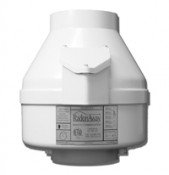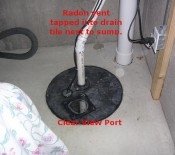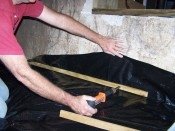Hamilton, ON - Canadian Installation - High radon levels mitigated
by Steve
(Hamilton, Ontario, Canada)

We had extremely high Radon levels in our (new to us) house. (4x the allowable limit.) This was confirmed by our Safety Sirens Electronic Radon monitor and a mail away test kit.
I e-mailed Val after reading through his site and he was very helpful.
My house is 1940's and has solid clay type very hard dense earth under the cement slab in the basement without and crushed stone so naturally it doesn't breath well.
With the help of my dad we broke the floor with a jack hammer in a rough 12"x12" area.
We then dug down 2 feet. This was painstaking because the earth was so dense and has clay mixed in with it. Took a Jack Hammer and a Hammer Drill to break the earth loose over a 4 hour period! (Broke the Hammer drill too)
I know I could have just cut a round hole and excavated a channel by hand but I wanted to go the extra mile and have nice sized crushed gravel pit surrounding the Pipe.
Next we poured in 6" of crushed gravel that you would find in the concrete / roofing isle.
On top of this we put a 3" ABS pipe with a commercial floor drain on the end to act as a screen (to keep gravel out) - See pictures below.
We then filled the remaining cavity around the pipe with crushed stone until 4" from the top.
We cut to size some cardboard to put down on top of the stone, and then put our concrete patch over that. The cardboard stops the concrete from seeping into the crush gravel and also helps absorb moisture when the concrete is curing or so my Italian dad says... Who am I to argue with a master tradesmen. LOL
We kept the pipe sloped so that if there is any moisture in the tube it can drain down into the pit. (45o ABS pipe facilitates this)
On the output end of the fan we used
Our chimney is no longer used as we have high efficiency gas appliances that direct vent out of the side of the house and we don't have or plan on having a fireplace.
We pressure tested the length of tube to ensure it was sealed the whole way up to the roof so no radioactive vapors escape before we pushed it down the inside of the chimney.
We pushed the tube down the chimney because it was easier. We did drop a weight with a fish-line down the chimney first, which had the tube tides to the other end. This helped greatly getting the tube down the chimney fairly easy.
We also sealed around the black tube at the top of the chimney, between the Flue (red part of the chimney) and the tube with high expandable foam for an airtight seal. We did this so that fumes from the pipe can't back-draft down the chimney and so that the pipe is naturally warm the whole way up to the roof because it's inside the chimney which is inside the middle of the house until the last 5 feet where it pops out of the roof.
This will keep the tube from freezing up in the crazy cold winters here, carrying any moisture-vapor from under the floor.
We used the Radon Away brand fan and got the strongest one I think they carry. (501) The reason we installed it inside was because we know the fan would be 100% sealed and because we have an electronic monitor plugged in near it to warn us of any problems / leaks. (Not shown in pictures)
If anyone has any questions about my install please feel free to e-mail me at: steven AT cedrone DOT com. (didn't type out e-mail address as is to prevent spam bots)
Comments for Hamilton, ON - Canadian Installation - High radon levels mitigated
|
||
|
||













